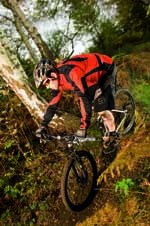 FRAME
FRAME
The Norco Fluid frame ticks all the boxes. Externally machined head tube, sloping top tube, good tyre clearance, full range of saddle height adjustment, replaceable mech hanger, bearing pivots, true four-bar linkage suspension and a stiff rear end. Two shock positions on the rocker let you toggle between 108 and 136mm of rear-wheel travel. The long-travel setting is the position closest to the seat tube and it’s the one that we used, as the amount of travel is better suited to the weight of the bike. Moving the shock position has no appreciable effect on the bike’s geometry.
SUSPENSION
A U-turn adjuster on the RockShox Tora fork allows you to set the travel anywhere between its 85-130mm range by simply twisting the dial. The rebound adjuster offers a wide range of adjustment but it has a small window of usable damping. And because the dial only has a 90-degree range of movement, small changes at the adjuster dramatically affect the performance of the fork. The Fox Float R shock has minimum ProPedal (platforming) and it’s the right choice as the Norco is all about the descents.
WHEELS
All of the bikes in this test have Shimano rear hubs because they are reliable and, if anything does go wrong, spare parts are easy to source. Build quality of the wheels on the Norco seemed pretty good to start with, but the spokes in the rear wheel lost a lot of tension after a couple of outings. No major problem, though, as the rim was still true and any dealer worth its salt will happily give it a once over with a spoke key.
COMPONENTS
Being £100 cheaper than most of the other bikes in this test meant that something had to give, and in this instance it’s the brakes. The Hayes Soles are basic single-piston units, so you have to manually adjust the inner piston with an Allen key as the pads wear down. Also, because the rotors are actually pushed over by the main piston to contact the static piston, the brakes don’t feel anything like as good as the twin-piston Avids or Shimano brakes. Yes, they are miles better than rim brakes — and because they are hydraulic they don’t require the constant cable maintenance of mechanical disc brakes — but you’ll eventually want to
PERFORMANCE
Out of the box, the Norco Fluid 3 has a good riding position. The cockpit is roomy but not stretched and all the contact points are in the right places. Even if, at 25in, the handlebar is too narrow. Suspension performance didn’t feel as good as the Trek or Specialized but most of that can be attributed to the fork. After two rides the RockShox Tora 318 developed a disconcerting metal-on-metal knocking. The damping still worked but something was definitely amiss with its innards. At almost 35lb, weight is a definite issue on the Norco and it’s noticeable that it’s concentrated at the rear end of the bike. Obviously this is less of a problem on the descents, with gravity working in your favour, but there is no escaping it on the climbs, as the Norco is the best part of 5lb heavier than the shorter-travel bikes on test.
VERDICT
The Norco Fluid 3 was always going to be at a slight disadvantage in this test as it is one of the cheaper bikes. And while the more expensive Fluid 2 will be a few pounds lighter, the Fluid range is never going to compete on weight as the frames are built super stout. For that reason if you’re a big guy, and by that we mean 14 stone-plus, then the Norco will be right up your street as the frame is built to last, has good rear suspension and the geometry is dialled. For the average UK trail rider, the Norco 3 is over-built, unless of course you’re planning on doing more drops and jumps than XC hacking — then all you’ll have to worry about is the fork.
MBR RATING: 7/10



